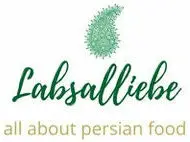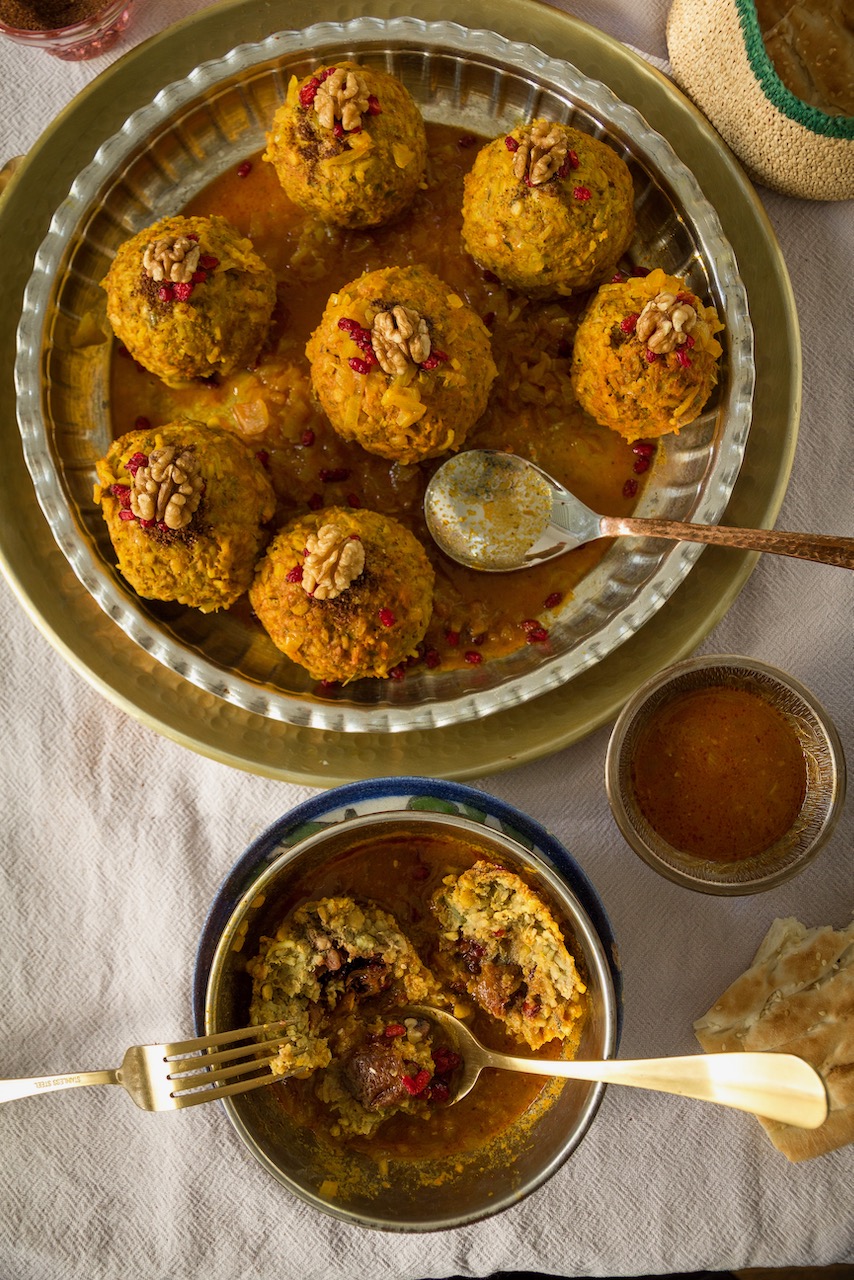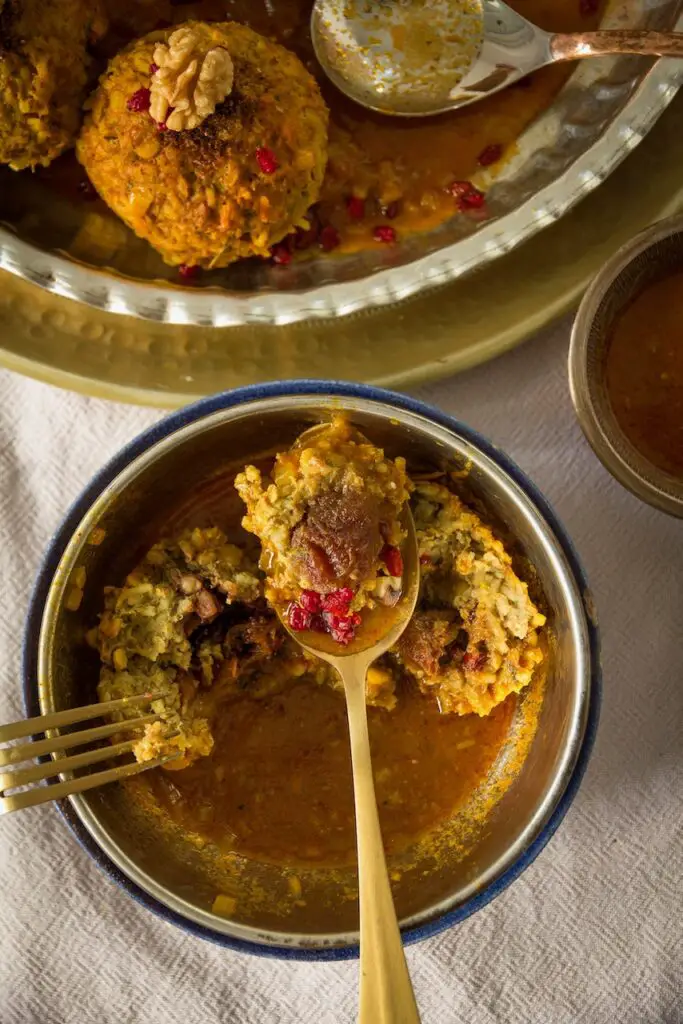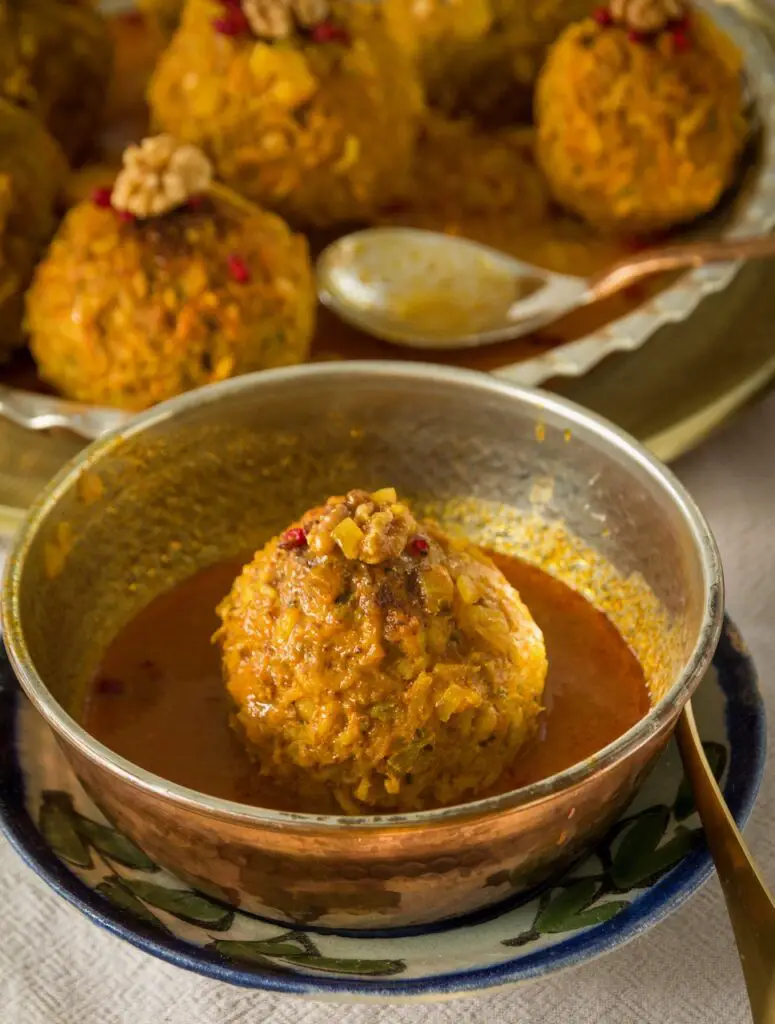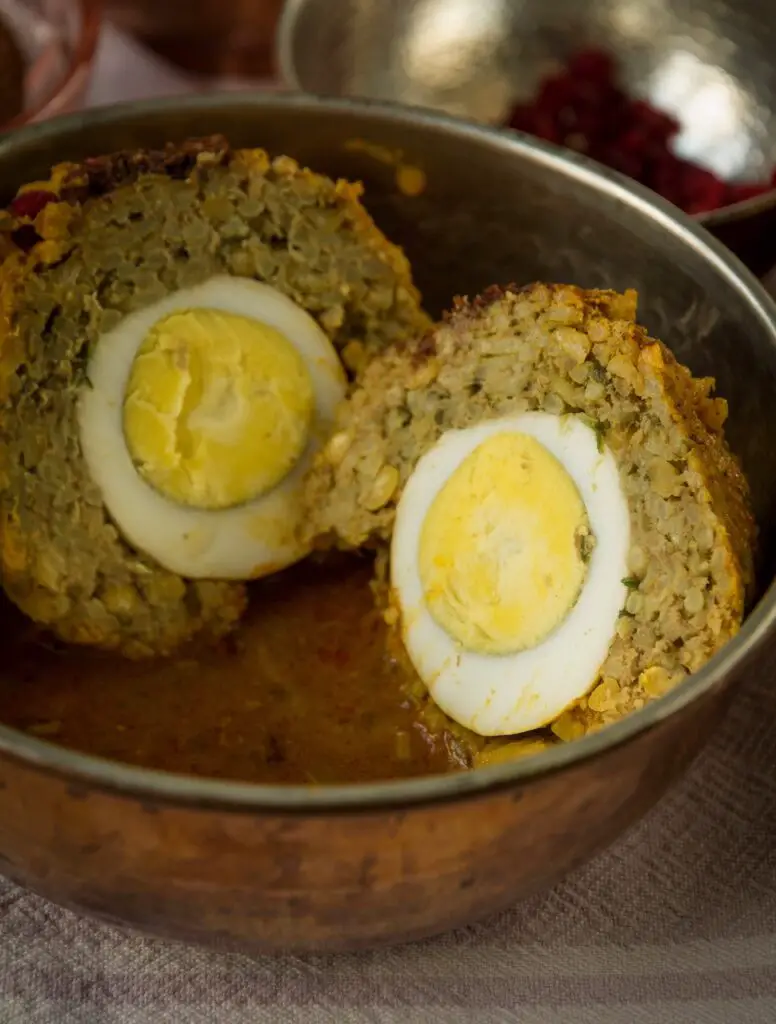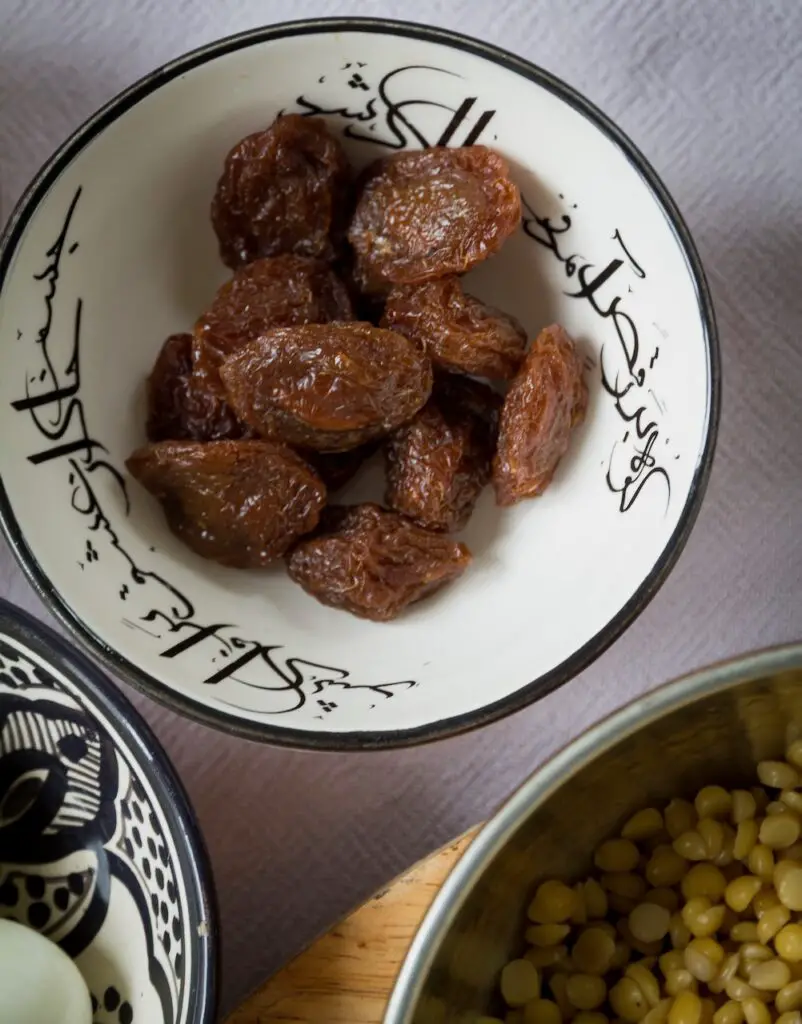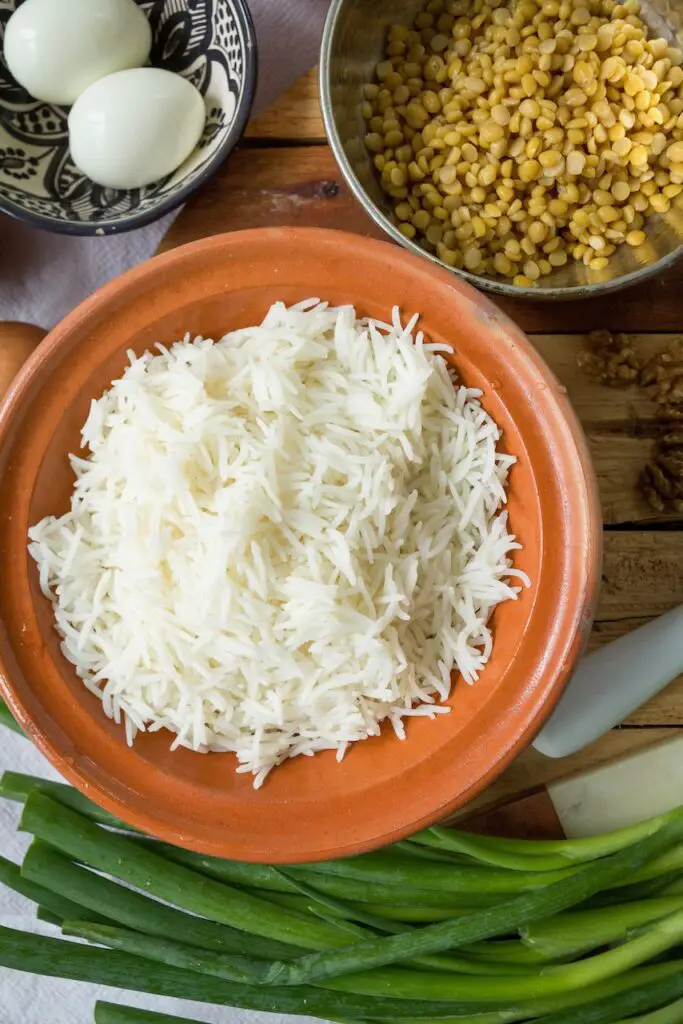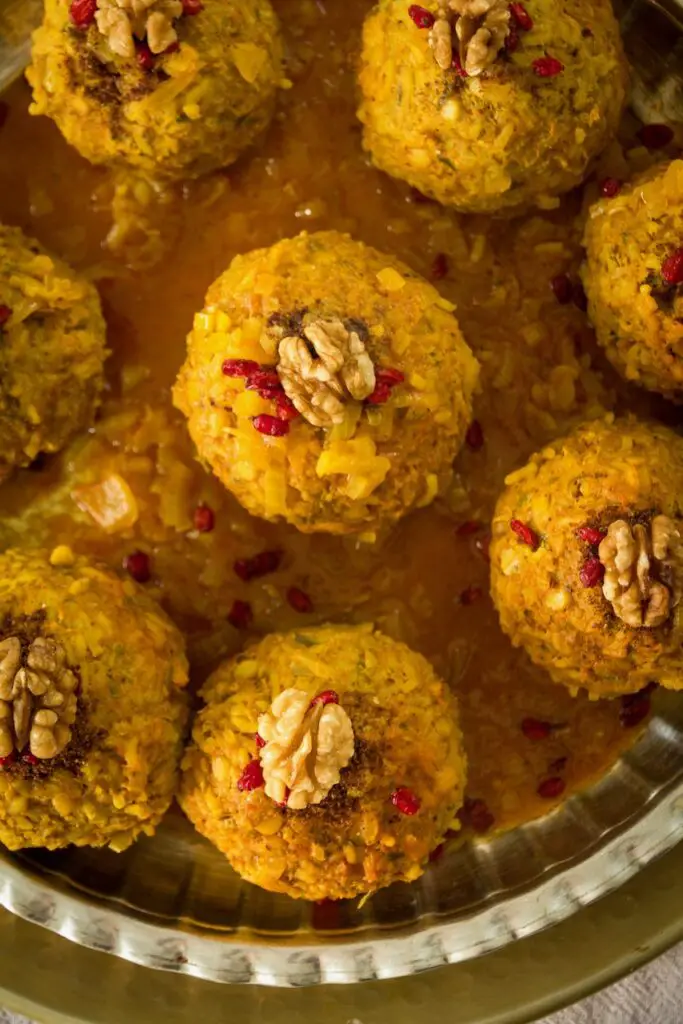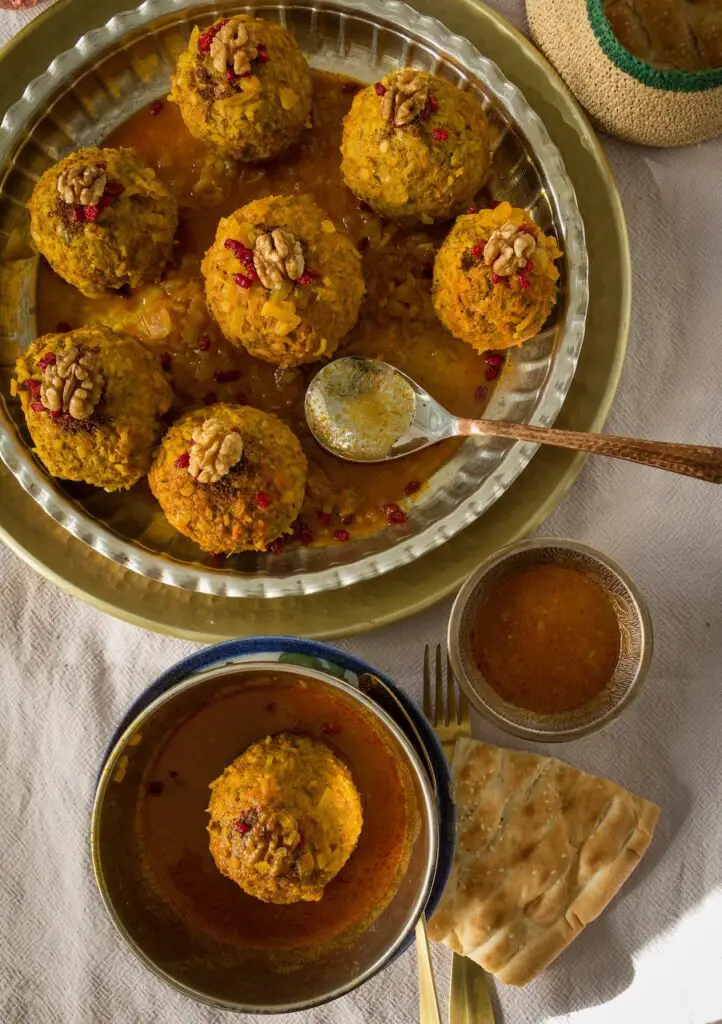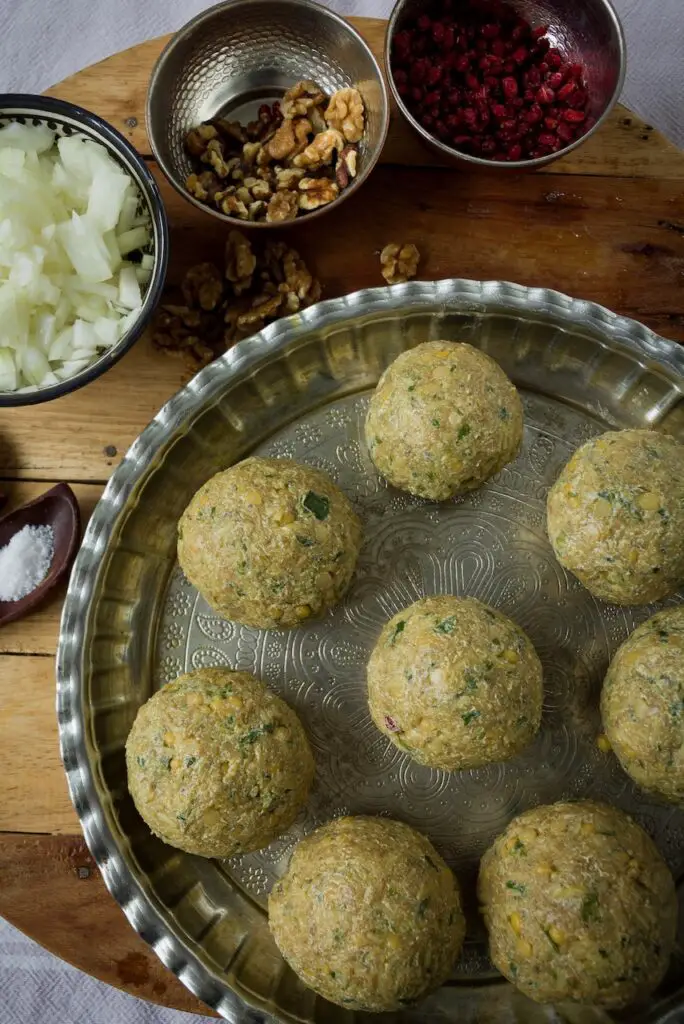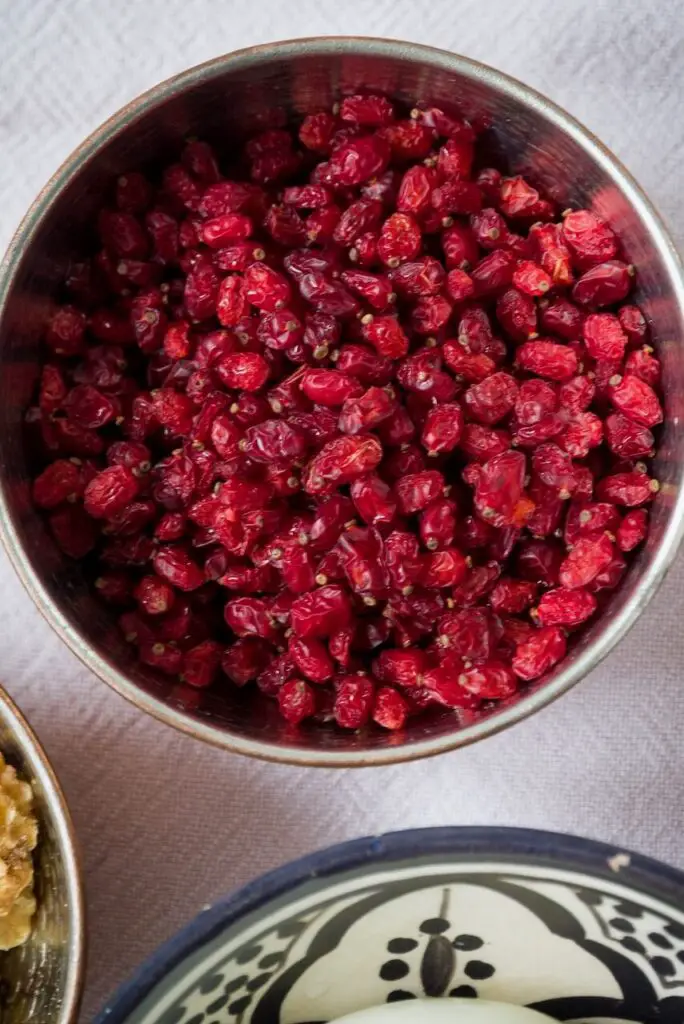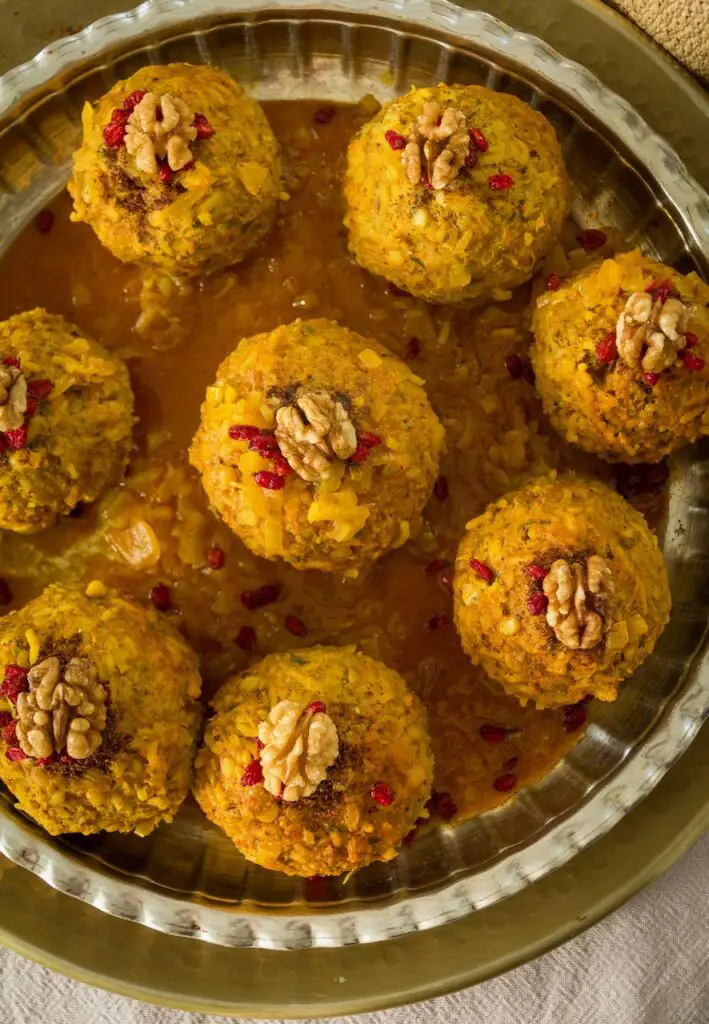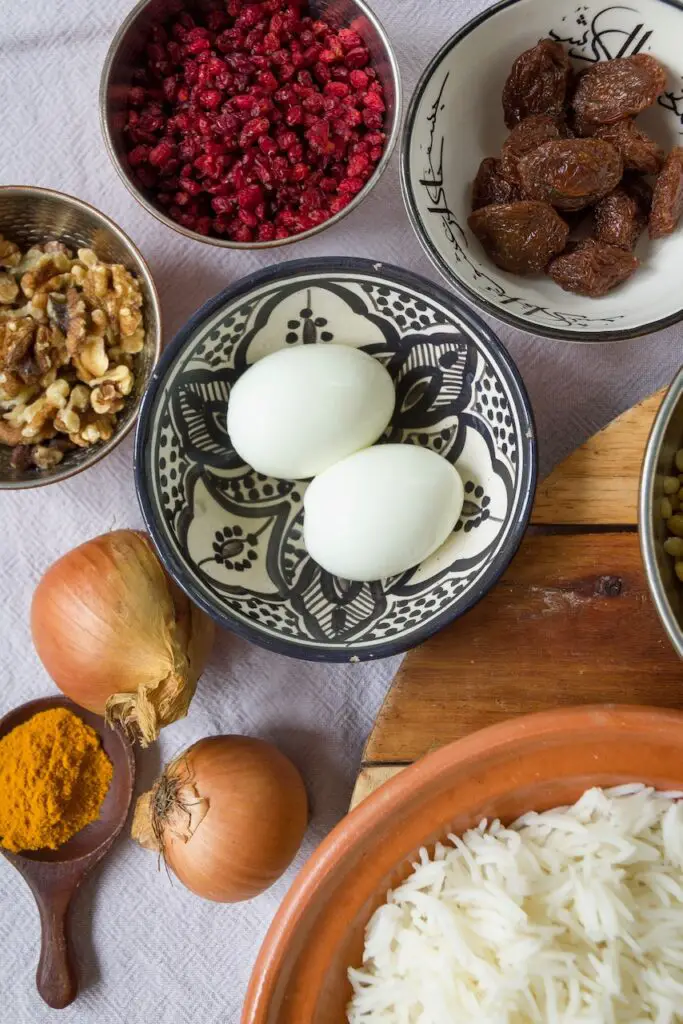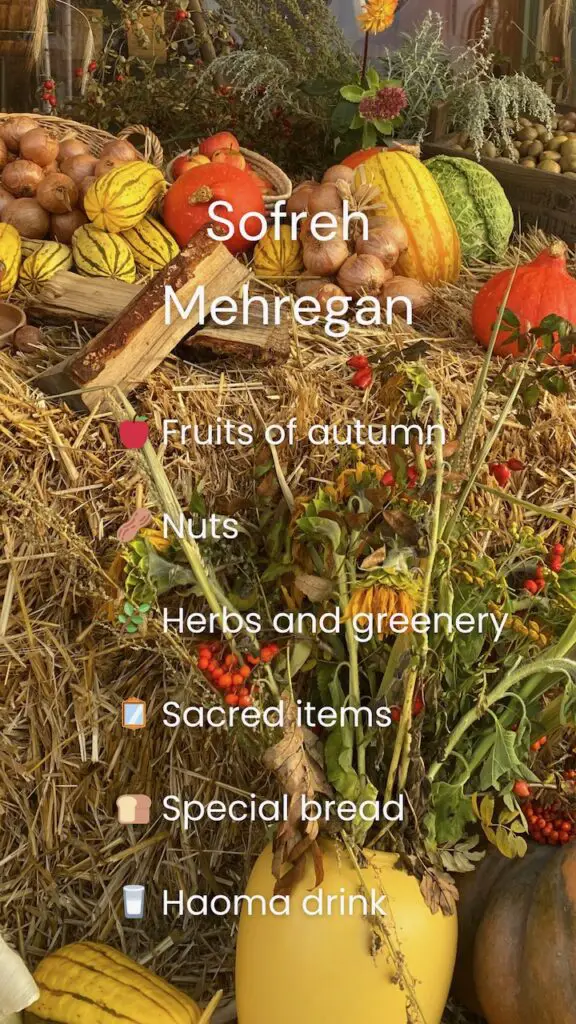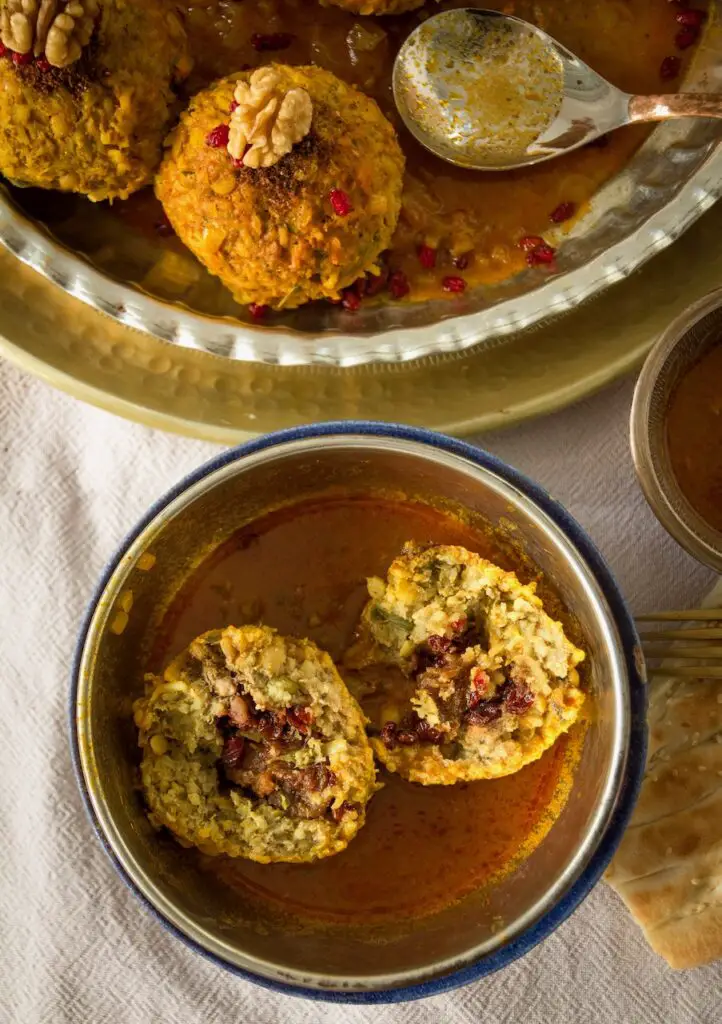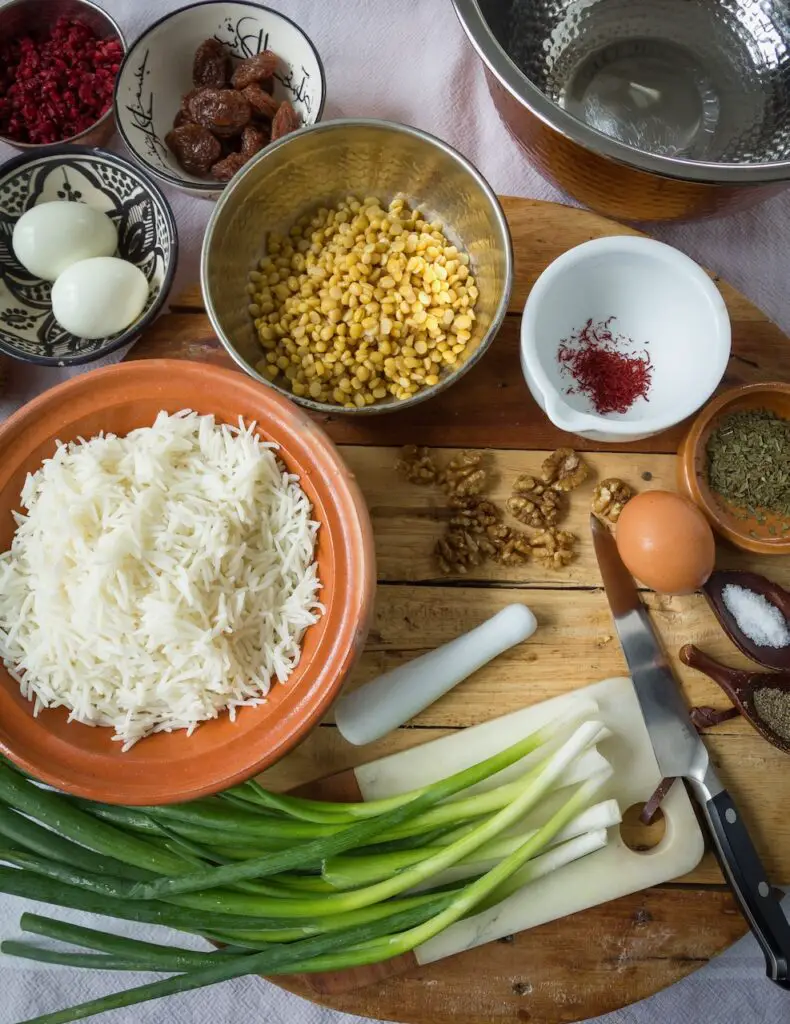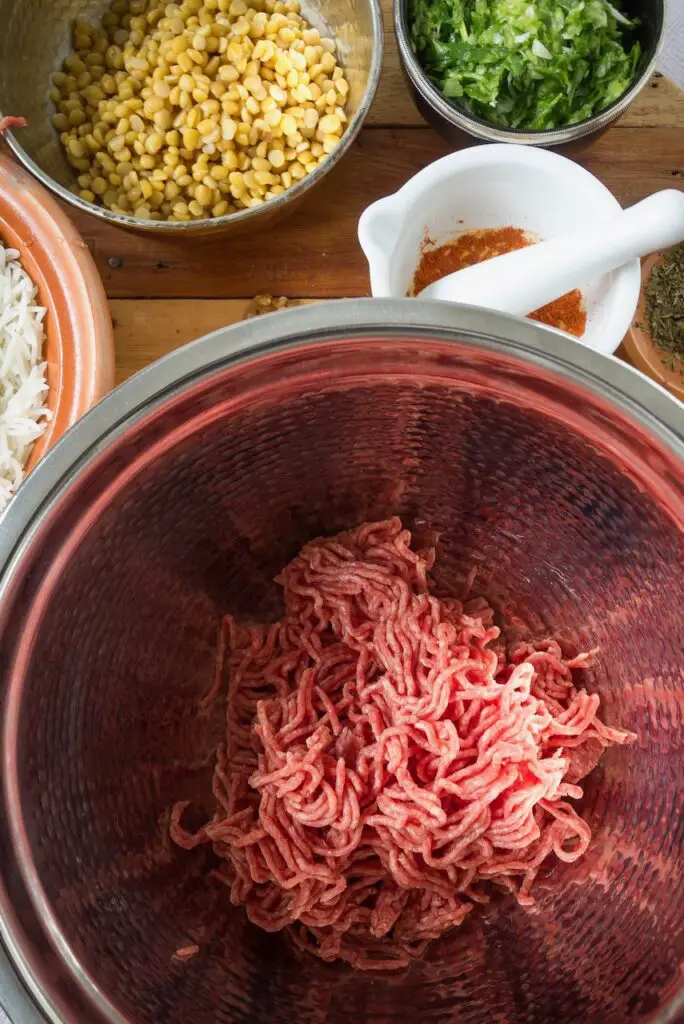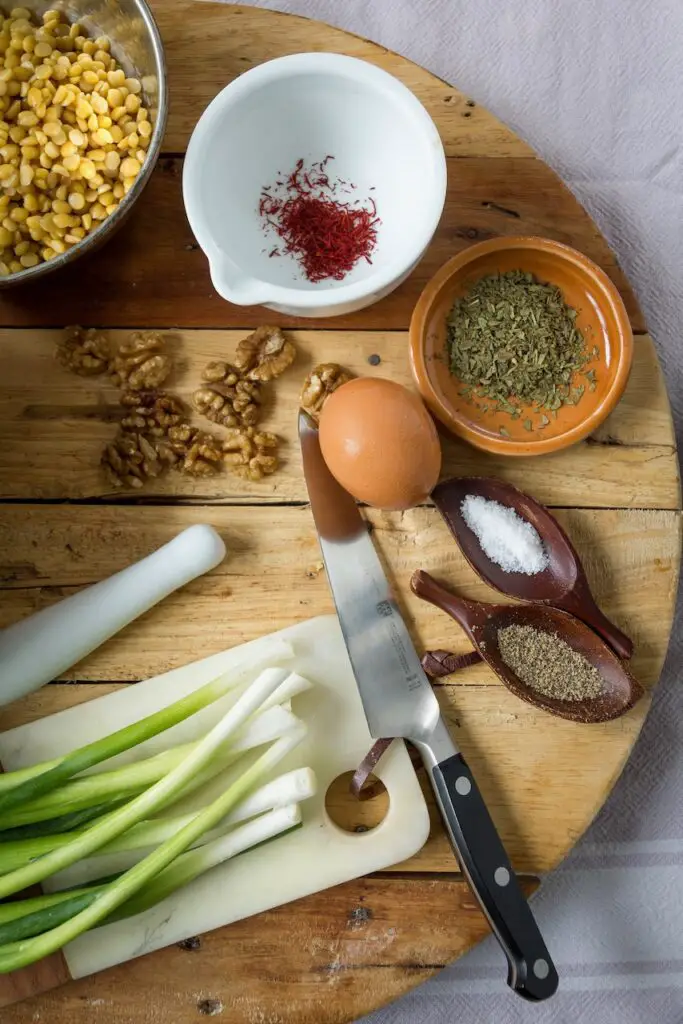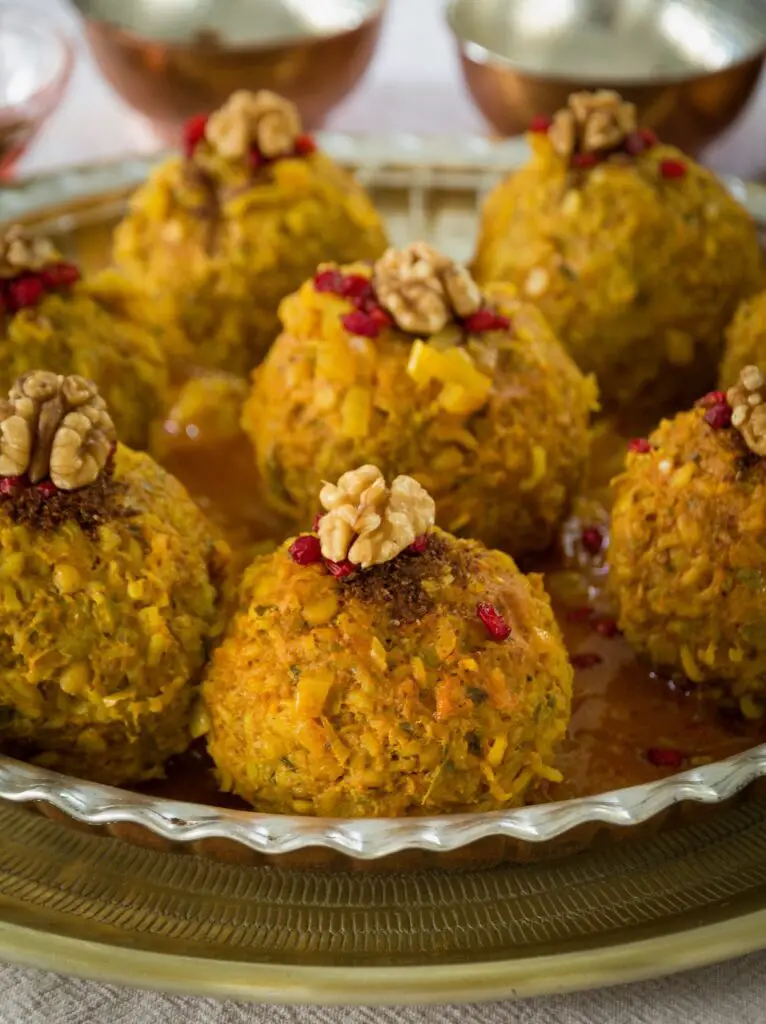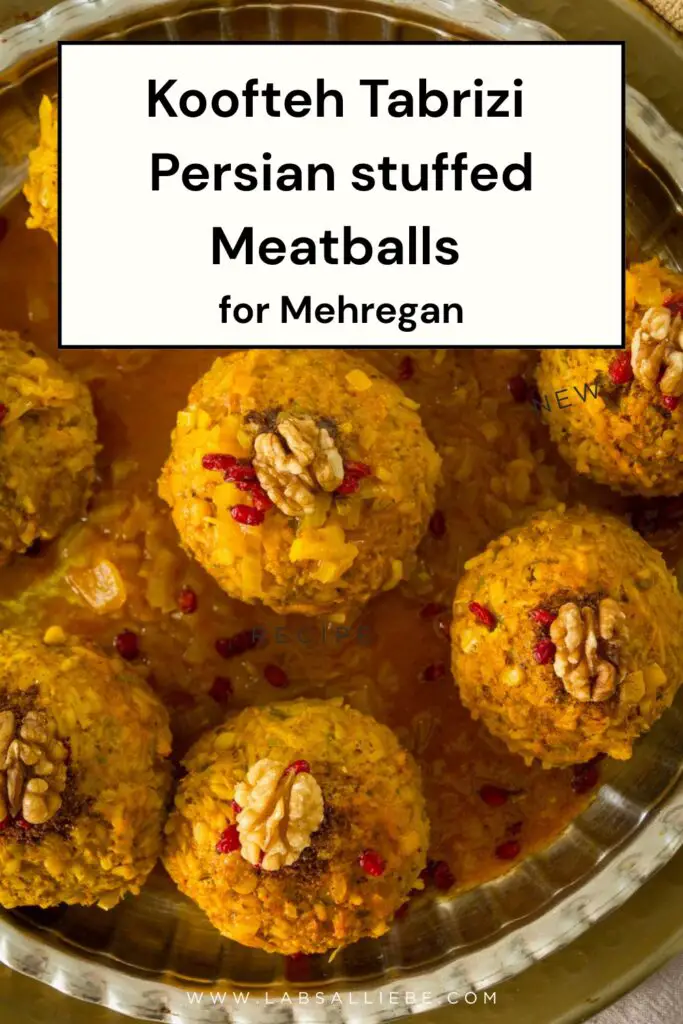Prepare Koofteh Tabrizi – Persian stuffed Meatballs for Mehregan, the joyful Persian autumn and harvest festival. This traditional dish hails from Tabriz, a historic city in northwest Iran, and it delights with its fruity, tangy, and savory flavors. Unlike German potato dumplings (Klöße), which serve as a side dish, Koofteh Tabrizi takes center stage as a main course.
I made my version with rice, ground beef, yellow split peas, saffron, tarragon, spring onions, turmeric, and sumac in a fragrant, simmering broth. Some meatballs I stuffed with hard-boiled eggs, while others I filled with dried Mirabelle plums (Aloo Bukhara), walnuts, and barberries. Families often personalize their Koofteh with different spices, nuts, herbs, and dried fruits. Sometimes, they even cook one giant meatball and share it among everyone at the table!
Watch my preparation video on Instagram
WHAT ARE YELLOW SPLIT PEAS (LAPEH)?
Yellow split peas, or Lapeh, are peeled, split chickpeas, also known in Indian cuisine as Chana Dal. They are packed with protein, folate, vitamins, and minerals, making them excellent for vegetarians, pregnant women, diabetics, and athletes. In Persian cooking, we also use it in Khoresht-e Gheymeh (Persian lamb stew), Dolmeh (stuffed vegetables), and Abgoosht.
WHAT IS ALOO BUKHARA?
Aloo Bukhara means “plum of Bukhara” and refers to a variety of plums and their dried form. This fruit traveled along the Silk Road from the ancient city of Bukhara in Uzbekistan into Iran, Afghanistan, India, and beyond.
We love Aloo Bukhara for its sweet-tart flavor. In Persian and Central Asian kitchens, dried plums enrich stews, rice dishes, and koofteh with a deep, fruity note. In South Asia, they brighten chutneys, curries, and festive sweets.
Dried Aloo Bukhara, also called Majlesi or golden plums, are rich in fiber, potassium, and antioxidants. To use them, simply soak in warm water and add to your dish. If you can’t find them, prunes or dried apricots make a good substitute.
HAPPY MEHREGAN
Every autumn, when day and night stand in perfect balance, Persian families come together to celebrate one of the most beautiful and meaningful festivals of the year: Mehregan, the Festival of Mehr.
Often called the Autumn Norooz, Mehregan is considered the second most important Persian celebration after Norooz. It is a time of gratitude, love, light, and harvest – a festival that has been passed down through generations for thousands of years. In 2024, this ancient tradition was officially recognized as UNESCO Intangible Cultural Heritage, a wonderful acknowledgement of its importance. Today, it continues to shine not only in Iran, Afghanistan, Tajikistan, Uzbekistan, Azerbaijan and Tajikistan, but also in Persian communities across the world.
WHAT IS MEHREGAN?
Mehregan is closely tied to the autumn equinox, just as Nowruz is tied to the spring equinox. In the past, people marked time by the balance of day and night, and Mehregan was the signal of autumn’s arrival. Today, Zoroastrians in Iran celebrate Mehregan on the 10th day of the Persian month of Mehr, usually in early October. In Khorasan, it was once known as Jashn-e Sar Mizo and held at the very start of Mehr. Wherever Persians live, Mehregan remains a celebration of love, gratitude, and community.
THE MEANING OF “MEHR”
The word Mehr (or Mitra) comes from the ancient Indo-Iranian root miθra, meaning friendship, love, light, and connection.
- In Zoroastrian texts, Mehr stands for truth, justice, and loyalty, often linked to the sun.
- In Roman times, Mithra was worshipped as the invincible sun (Sol Invictus).
- In modern Persian, Mehr simply means love and friendship. And that is exactly what Mehregan celebrates.
A FESTIVAL OF LOVE, LIGHT AND HARVEST
Alongside Norooz (the spring festival), Tirgan (the midsummer celebration of water), and Yalda (the winter solstice), Mehregan stands as one of the most cherished ancient Persian festivals. It is more than just a harvest feast – it is a time to celebrate friendship, kindness, and gratitude. Families gather, tables are decorated with autumn fruits and nuts, music and dance fill the air, and prayers are offered for health and happiness.
This year, Mehregan falls on October 2nd, and just like every year, it brings people together in joy and harmony.
THE ZOROASTRIAN SPIRIT OF MEHREGAN
At the heart of Mehregan lies the wisdom of Zoroastrianism, the ancient Persian faith. Followers celebrate with colorful rituals, family gatherings, and joyous festivities, always guided by three timeless values from their holy book, the Avesta:
💭 Good thoughts
🗣️ Good words
🤲 Good deeds
Just like Norooz, Mehregan is a reminder that the way we live matters – that truth, kindness, and light should guide us through every season of life.
SOFREH MEHREGANI – THE TABLE OF AUTUMN
Much like the Haft Sin of Norooz, Mehregan has its own symbolic table, the sofreh, traditionally laid with a purple cloth.
On it you’ll find:
🍎 Fruits of autumn – apples, grapes, quinces, pomegranates, figs, dates, medlar, persimmons
🥜 Nuts – almonds, pistachios, walnuts, hazelnuts
🌿 Herbs and greenery – marjoram, myrtle, cypress branches
🪞 Sacred items – a mirror, rosewater, silver coins, sweets
🍞 Special bread – baked from seven grains: wheat, barley, rice, chickpeas, lentils, mung beans, millet
🥛 Haoma drink – a ritual mix of a sacred plant with milk or water
The sofreh is more than food – it’s a table of symbols, gratitude, and blessings.
HOW WE CELEBRATE MEHREGAN
On Mehregan, everyone puts on new, flower-decorated clothes. We set a colorful table, just like the Haft Sin for Norooz. And we arrange autumn fruits—apples, grapes, quinces, and pomegranates—alongside wild marjoram, almonds, pistachios, rosewater, a mirror, the holy Avesta book, kajal, silver coins, autumn flowers, and sweet treats.
We burn Esfand, a mix of rue and myrtle leaves, and carry the smoking pan through the room, circling it over thee heads to protect us from illness, the evil eye, and bad luck. We also decorate a bowl of water with marjoram extract and lotus seeds.
At noon, the family gathers for prayer in front of the mirror. Then we drink sharbat, paint our eyes with kajal for good luck. We throw marjoram and lotus seeds at each other, laugh, hug, and exchange gold and silver coins as blessings. Music always fills the air at Persian festivals. We dance joyfully until evening, and later we feast on grilled lamb. When night falls, fireworks light up the sky, and the celebration ends in sparkle and laughter.
INGREDIENTS FOR PERSIAN STUFFED MEATBALLS
INGREDIENTS FOR THE MEATBALLS
80 g yellow split peas (Lapeh)
150 g rice*
300 g spring onions
5 tbsp fresh tarragon (or 2 tbsp dried*)
½ tsp saffron*
500 g ground beef
1 egg (for meatballs)
Salt & pepper
INGREDIENTS FOR THE FILLING
2 eggs (hard-boiled)
2 tbsp barberries
12 dried Mirabelles (Aloo)
8 walnuts*
INGREDIENTS FOR THE BROTH
2 onions
1 tsp turmeric*
1 tbsp butter (optional)
2 tbsp tomato paste (optional)
Saffron essence (optional)
Salt, pepper
INGREDIENTS FOR THE TOPPING (optional)
2–3 tbsp sumac*
1 tbsp barberries*
8 walnuts*
HOW TO MAKE PERSIAN STUFFED MEATBALLS
1. PREPARE THE MEATBALLS
Soak split peas and rice overnight.
Cook the split peas for 30 minutes until tender, and par-cook the rice until just soft. Chop spring onions and tarragon finely.
Grind saffron with a little sugar.
Mix spring onions, tarragon, split peas, and beef, then add rice, saffron, egg, salt, and pepper. Knead well.
For the saffron essence, pour some hot water into the empty saffron bowl with the leftover ground saffron and set it aside.
Prepare another bowl with lukewarm water to wet your hands.
2. PREPARE THE FILLING
Hard-boil eggs.
Soak barberries to remove debris.
Shape meat mixture into tennis-ball-sized balls, make a hole in the center, and fill with either eggs or a mix of Aloo, barberries, and walnuts.
Seal and shape the balls.
3. MAKE THE BROTH
Finely dice the onion.
Heat oil in a pan and sauté the onions until golden brown.
Add butter, then season with turmeric, tomato paste (optional), saffron essence (optional), salt, and pepper.
Pour in 1 liter of hot water and bring to a gentle simmer.
Carefully place the koofteh (meat and rice balls) into the broth.
Cover and cook on low heat for about 1 hour, allowing the broth to reduce by half.
4. SERVE
Place a meatball in a deep plate, pour over some broth, and sprinkle with sumac, barberries and top with a walnut.
The dish pairs perfectly with Mast-o-Khiar (Persian yogurt with cucumber), Mast-o-Musir (wild garlic yogurt), and Nan-e Barbari (Persian flatbread).
BEFARMAYID!
Susan
The items marked with * are affiliate links, referral links. If you buy through this link, I get a small commission. The price stays the same for you and you can easily support my efforts. A big thank you ♥
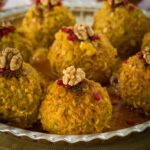
Koofteh Tabrizi – Persian stuffed Meatballs for Mehregan
Families often personalize their Koofteh with different spices, nuts, herbs, and dried fruits.
Ingredients
INGREDIENTS FOR PERSIAN STUFFED MEATBALLS
INGREDIENTS FOR THE MEATBALLS
- 80 g yellow split peas Lapeh
- 150 g rice
- 300 g spring onions
- 5 tbsp fresh tarragon or 2 tbsp dried
- ½ tsp saffron
- 500 g ground beef
- 1 egg for meatballs
- Salt & pepper
INGREDIENTS FOR THE FILLING
- 2 eggs hard-boiled
- 2 tbsp barberries
- 12 dried Mirabelles Aloo Bukhara
- 8 walnuts
INGREDIENTS FOR THE BROTH
- 2 onions
- 1 tsp turmeric
- 1 tbsp butter optional
- 2 tbsp tomato paste optional
- Saffron essence optional
- Salt pepper
INGREDIENTS FOR THE TOPPING (optional)
- 2-3 tbsp sumac
- 1 tbsp barberries
- 8 walnuts
Instructions
HOW TO MAKE PERSIAN STUFFED MEATBALLS
PREPARE THE MEATBALLS
-
Soak split peas and rice overnight.
-
Cook the split peas for 30 minutes until tender, and par-cook the rice until just soft.
-
Chop spring onions and tarragon finely.
-
Grind saffron with a little sugar.
-
Mix spring onions, tarragon, split peas, and beef, then add rice, saffron, egg, salt, and pepper. Knead well.
-
For the saffron essence, pour some hot water into the empty saffron bowl with the leftover ground saffron and set it aside.
-
Prepare another bowl with lukewarm water to wet your hands.
PREPARE THE FILLING
-
Hard-boil eggs.
-
Soak barberries to remove debris.
-
Shape meat mixture into tennis-ball-sized balls, make a hole in the center, and fill with either eggs or a mix of Aloo, barberries, and walnuts.
-
Seal and shape the balls.
MAKE THE BROTH
-
Finely dice the onion.
-
Heat oil in a pan and sauté the onions until golden brown.
-
Add butter, then season with turmeric, tomato paste (optional), saffron essence (optional), salt, and pepper.
-
Pour in 1 liter of hot water and bring to a gentle simmer.
-
Carefully place the koofteh (meat and rice balls) into the broth.
-
Cover and cook on low heat for about 1 hour, allowing the broth to reduce by half.
SERVE
-
Place a meatball in a deep plate, pour over some broth, and sprinkle with sumac, barberries and top with a walnut.
Recipe Notes
The dish pairs perfectly with Mast-o-Khiar (Persian yogurt with cucumber), Mast-o-Musir (wild garlic yogurt), and Nan-e Barbari (Persian flatbread).
Save the recipe for later on Pinterest!
Have you cooked this or maybe another delicious recipe of mine? Feel free to leave me a comment below. If you tag your picture on Instagram with @labsalliebe and use the hashtag #labsalliebe, I won’t miss a post and will be happy to leave you a comment as well. Can’t wait to see your creations.
♥♥♥♥♥♥♥♥♥♥♥♥♥♥♥♥♥♥♥♥♥♥♥♥♥♥♥♥♥♥♥♥
